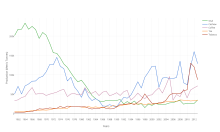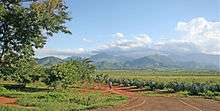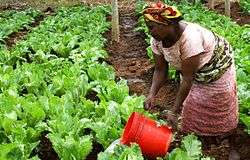Agriculture in Tanzania

Agriculture is main part of Tanzania's economy.[1] As of 2016 Tanzania has over 44 million hectares of arable land with only 33% of this amount being cultivated. More than 80% of the poor population live in rural areas and almost all of them are involved in the farming sector.[2] Land is a vital asset in ensuring food security and among the main food crops in Tanzania are maize, sorghum, millet, rice, wheat, beans, cassava, potatoes and bananas. Agricultural products also contributes largely to the country's foreign exchange earnings and over 1 billion dollars is earning from cash crop exports.[3] Main cash crops include Coffee, Sisal, Cashew nut, Tea, Cotton and Tobacco. At one point in history Tanzania was the largest producer of sisal in the world.[4]
The agriculture sector faces various challenges and has been the governments top priority to develop to reduce poverty.[5] Farming efficiently has been a challenge of many farmers and lack of finances and lack of farming education has left many farmers subsistence farmers. Farm sizes remain very small with the average plot size being around 2.5 ha.[6]
Lack of agricultural technology, droughts, floods or agriculture temperature shocks, severely endanger the living standards of most of population and create huge increases in unemployment, hunger, malnutrition and diseases rates (with especial mention to HIV/AIDS), as well as, in really severe cases, mortality rates due to starvation.
Furthermore, important shocks in commodity prices would mean a decrease on exports revenues and, as a consequence, an increase of the trade deficit and, as it is correlated, also of the budget deficit. Therefore, it would hinder even more the development of the country, with especial emphasis in the prospective GDP growth rates, as agriculture represents the 32.4% of the total GDP.[7]
Soil and Topography
Tanzania has a total area of 945,000 sqkm with inland lakes covering 59,000 sqkm (6%). The Great Rift Valley runs from north to south of the country and contains most of the countries lakes. The country is home to the highest point in Africa, Mount Kilimanjaro and the lowest point in the continent Lake Tanganyika.[8] Tanzanian soil types vary drastically throughout the country as the each region gets varied amounts of rainfall. There are six main types of soil types in the country:[9]
- Volcanic soils: predominantly in the northern highland regions.
- Sandy soil: predominantly in the coastal regions mainly used for grazing.
- Granite/Gneiss soil: predominantly in the northern region of Mwanza and Tabora
- Red soils: predominantly in the central plateau
- Ironstone soils: predominantly in the western regions like Kagera and Kigoma
- Vertisol: called mbuga black soil, spread across most of the country.
Cash Crops

Coffee Production
Coffee is grown on a large scale on both estates and by smallholders that form co-operatives and involves over 400,000 farmers. Coffee has been grown in the country since the colonial times and is a major export crop, earning over 17% of the country's foreign exchange. Tanzania mainly grows the arabica type, however, small farms in the Kagera grow Robusta coffee. Tanzanian coffee is globally more commonly known as Kilimanjaro Coffee.[10]
Sisal Production

Sisal was brought to Tanzania by the Germans in the late 19th century from Mexico. Sisal grows in the northern regions of the country, in regions such as Tanga and Kilimanjaro. At the time of independence in 1961 Tanzania was the largest producer of Sisal in the world. Sisal production continued to decline after the Ujamaa movement and the continued depreciation of world prices. In the recent years the government has tried to liberalize the sector to encourage growth to increase export revenues.[11]
Cashew Production
Cashew production in Tanzania began towards the end of the British protectorate in the 1950s. Tanzania is the 8th largest producer of the nut in the world and the 4th largest in Africa.[12] Poor regulation and lack of reliable payments to farmers has plagued production. Cashew mainly grows in the southern regions of the country such as Mtwara and Lindi and more than 90% of the nuts are exported in raw form. The raw nuts are mainly exported to India for processing due to a very small processing capacity domestically. The lack of domestic processing firms has cost the country vital foreign revenue and thousands of jobs. The Government has been struggling to find potential investors to revive the cashew processing industry.[13]
Statistics
Main Crop Production

Non-cash crop production from 2013 as reported by the Food and Agriculture Organization of the United Nations:[14]
| 2013 | Area Harvested | Yield Hg/Ha | Production, 1000 tonnes |
|---|---|---|---|
| Casava | 950,000 | 56,842 | 5,400 |
| Maize | 4,000,000 | 11,750 | 4,700 |
| Sweet Potatoes | 675,000 | 45,926 | 3,100 |
| Sugar Cane | 30,000 | 1,000,000 | 3,000 |
| Rice, Paddy | 900,000 | 20,889 | 1,880 |
| Potatoes | 175,000 | 74,286 | 1,300 |
| Beans, dry | 1,300,000 | 8,846 | 1,150 |
| Sunflower seed | 810,000 | 13,370 | 1,083 |
| Sorghum | 900,000 | 9,444 | 850 |
| Groundnuts, with shell | 740,000 | 10,608 | 785 |
| Source: FAO | |||
See also
References
- ↑ "New Agriculturist: Country profile - Tanzania". www.new-ag.info. Retrieved 2016-02-07.
- ↑ "Tanzania Agriculture". www.tanzaniainvest.com. Retrieved 2016-03-11.
- ↑ "OEC - Tanzania (TZA) Exports, Imports, and Trade Partners". atlas.media.mit.edu. Retrieved 2016-03-11.
- ↑ "Tanzania Agriculture, Information about Agriculture in Tanzania". www.nationsencyclopedia.com. Retrieved 2016-03-11.
- ↑ "Reducing poverty through Kilimo Kwanza" (PDF).
- ↑ Gaddis, Isis. "Land of opportunity: Should Tanzania encourage more large-scale farming?". AfricaCan End Poverty. Retrieved 2016-03-11.
- ↑ "Tanzania. Poverty Report." (PDF).
- ↑ "Tanzania". www.infoplease.com. Retrieved 2016-03-11.
- ↑ "Tanzania". www.fao.org. Retrieved 2016-03-11.
- ↑ "Tanzania's Coffee Sector: Constraints and Challenges in a Global Environment" (PDF). worldbank.org. World Bank. June 2003. Retrieved 7 February 2016.
- ↑ "Sisal: The most useful plant you've never heard of - CNN.com". CNN. Retrieved 2016-02-14.
- ↑ "Tanzania: Going nuts over cashew - African Business Magazine". African Business Magazine. Retrieved 2016-02-14.
- ↑ "Tanzania's Cashew Sector: Constraints and Challenges in a Global Environment" (PDF). worldbank.org. World Bank. June 2004. Retrieved 2 February 2016.
- ↑ "Tanzania Cereals Production - Open Data for Tanzania". Knoema. Retrieved 2016-03-11.
